You need to upgrade your Flash Player
Please visit Adobe's Flash Player site to upgrade the most recent version.
Thank you.
If you are having issues with installing Adobe Flash Player, please make sure that all "pop-up killer" applications are turned off and you reinstall
the Adobe player.
Korinthia
Information about Korinthia
Vacation and accommodation in Greece is a complete Travel Guide for Greece. In Vacation-Greece you will find information on Greek islands and a list of hotels and villas in Peloponnese, studios and apartments for all budgets. Find hotel offers in Peloponnese, see maps and photos of Peloponnese, book flights, ferry tickets, discover Peloponnese, book guided tours and make hotel reservations.

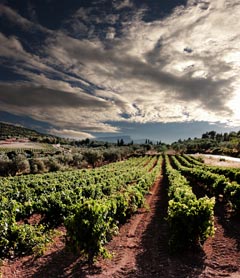 Coming from Athens, Corinthia is the first prefecture you come to in the Peloponnese, the first sign of warmth and excitement. The aromas of the sea, the mountains, the harvest of grapes and currants are all-encompassing, accompanied by the sound of bees buzzing around the sheds where the currants are drying. Here you'll rediscover some old Greek myths, learn that Nemean wine is called "Herakles blood" and that retsina is the teardrop of a certain wood nymph. You'll find out about gods, nereids and mortals. Zeus and Apolo. You'll come upon columns, sanctuaries and ancient palaces.
Coming from Athens, Corinthia is the first prefecture you come to in the Peloponnese, the first sign of warmth and excitement. The aromas of the sea, the mountains, the harvest of grapes and currants are all-encompassing, accompanied by the sound of bees buzzing around the sheds where the currants are drying. Here you'll rediscover some old Greek myths, learn that Nemean wine is called "Herakles blood" and that retsina is the teardrop of a certain wood nymph. You'll find out about gods, nereids and mortals. Zeus and Apolo. You'll come upon columns, sanctuaries and ancient palaces.
Cutting through Corinthia
Just before the Isthmus, to the right, the road veers off to Loutraki, a town built on the foothills of the Gerania range on the soil of Central Greece, yet still part of Corinthia prefecture.
The cloudless sky is reflected in the sea. You watch the carefree movements of the people on the beach, swimming and tanning themselves in the summer sun. But Loutraki also has hot springs, whose blessed waters gush from the earth with healing properties. Beyond Loulraki, heading west, you come to lake Vouliagmeni which is joined to the sea by a narrow channel
Near Perahora peninsula, with its picturesque bay, you see the first ruins at the back of the harbour - the Temples of Hera Akraia and Limenia.
This place gives one a foretaste of what to expect from the main sanctuary to Hera in the Peloponnese.
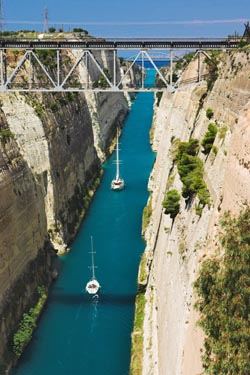 Returning to the main highway for Corinth, you pass the Isthmus, - the avlaki or "courtyard" as we Greeks call it - and head for one of the most important panhellenic shrines, the sanctuary of Poseidon at Isthmia (7th c. BC), near the village of Kiravrisi, where panhellenic games were held every other year.
Returning to the main highway for Corinth, you pass the Isthmus, - the avlaki or "courtyard" as we Greeks call it - and head for one of the most important panhellenic shrines, the sanctuary of Poseidon at Isthmia (7th c. BC), near the village of Kiravrisi, where panhellenic games were held every other year.
Adjacent to the archaeological site is a museum containing important finds. The paintings on glass are most impressive. From here the road leads to Kehries, the eastern port Corinth on the Saronic Gulf.
Ancient foundations, most of which are submerged, were excavated at the harbour's two quays.
Traces of the temple of Isis and an early Christian basilica constructed on top of the temple can be distinguished.
Immediately afterwards you reach Baths of Belle Helene (Loutro Elenis), a resort area with lovely beaches and hot springs, the seaside village of Almiri; and then Korfos a hamlet built at the head of a small bay.
The region is thick with pine and olive trees.
The coast and the little ports in the vicinity are unforgetable. Hard for a visitor to leave behind.
Here one can find good food and a house to stay in, surrounded by beauty.
Corinth yesterday and today
In the age of myth Corinthia was always being thrown into turmoil by tribes pouring into the Peloponnese from the Isthmus. With the setting of the Dorians (9th c. BC), Corinth's history began.
It beacame a great naval power and perfected the trireme. The Corinthians were the first to have the idea cutting through the Isthmus but were unable to accomplish this feat. Instead they invented and built a paved slipway, called the diolkos, to haul their boats overt Isthmus. They were foremost in the arts, particula ceramics. The 5th century was their most glorious period.
But with the success of Athena as a powerful force, Corinth was eclipsed and fell into decline.
In 146 BC the Romans completely destroyed the city. In 67 BC Nero tried his hand at digging through the Isthmus and got as far as a big trench, but works were abandoned with his death, and not until 1891-1893 did the canal finally become a reality .
Invasions and looting by barbarians threw Corinth into a new decline and the city was not heard from again until the early Byzantine era.
In 1521 a strong earthquake razed the city which rose again in about the 11th century.
In 1212 the Franks took over, holding on until 1395 when the Byzantines gained the advantage, only to sell the city to the Knights of Rhodes five years later. Corinth, with the most of the rest of the Peloponnese, fell to the Turks in 1458, became the property of the Knights of Malta for a time (1612), passed to the Venetians in 1687 and was recaptured by the Turks in 1715, They were ousted in 1822.
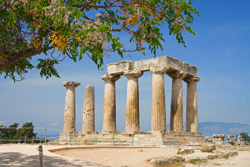 Today Corinth (Korinthos) ranks among Greece's most important cities and is a major transportation hub. The church of the Apostle Paul reminds us of the saint's Letters to the Corinthians and his preaching here. Its long waterfront is one of the most attractive spots in the city.
Today Corinth (Korinthos) ranks among Greece's most important cities and is a major transportation hub. The church of the Apostle Paul reminds us of the saint's Letters to the Corinthians and his preaching here. Its long waterfront is one of the most attractive spots in the city.
Its numerous pastry shops, restaurants, tavernas, bars, cinemas and nightclubs make Corinth lively in both winter and summer. In September and October a theatre festrival is held here with troupes from all over the Balkans as weil as a panhellenic amateur theatre contest. Ancient Corinth
The ruins of ancient Corinth are spread out at the foot of the huge rock of Acrocorinth. The monuments are mainly Roman, only a few are Greek.
You can trace the Long Walls which began at the summit of Acrocorinth and descended all the way to Lechaion (Leheo), the artificial harbour on the Corinthian Gulf.
Lechaion was the start of Lechaion road which led 1o the ancient agora. This was paved with flagstones and lined with sidewalks, arcades and shops. The area of the marketplace was filled with imposing buildings, temples and business emporia. The Doric temple of Apollo (6th c. BC with 1st c. AD restorations) stands on a knoll to the north of the agora;
it is the most important monument of that period. To the northwest of the agora lie the ruins of the 4th century BC theatre - which underwent some changes in the Roman era - and the Roman Odeon. The museum is in the southwest sector of the site. It contains mosaic floors, Mycenaean and Corinthian pottery, terra cotta sphinxes, statues of two supernatural beings, relief plaques, the Roman head of the Goddess Tyche and small objects of various kinds. On the north side of the building one can see the remains of the fountain of Glauke hewn out of the rock. Glauke, daughter of King Creon, was the reason why Jason deserted Medea. In revenge Medea sent her as a wedding gift a poisoned mantle which envelopped the girl in flames the moment she put it on. In order to save herself she leapt into the fountain which since then has borne her name.
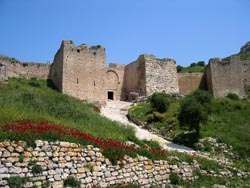
Acrocorinth
The imposing mass of Acrocorinth (Acrokorinthos)-rises out of the ground at the edge of the ancient city. At the top of the pinnacle, at an altitude of 575 metres, stood the acropolis of Corinth during ancient and medieval times. This is the largest and oldest fortress in the Peloponnese. The Franco-Byzantine-Venetian fortifications (built atop the ancient walls) ana Turkish additions have left deep signs of their successive claims to supremacy.
At the summit, which offers a magnificent view, there were a vast number of shrines and temples dominated by the Temple of Aphrodite. Lower down is Ihe Upper Peirene Spring.
Pausanias mentions that Peirene was a woman who was transformed into a spring by the tears she shed for her son who had been killed by Artemis.
The mountains of Corinthia
From Acrocorinth the road continues on to Nemea. Here the soil is yellow, dry, ideal for the cultivation of grapes. The whole district is covered with vines. The neighbouring village of Herakleio is a silent withness to the passing of the mighty Herakles. It was in this area that the legendary hero slew the fearsome Lion of Nemea.
There is not much left of ancient Nemea: three columns from the temple of Zeus, a few foundations, the outline of a palaestra and, 500 metres down road, the stadium. It was here that the panhellenic Nemean Games were held, in honour of some local hero. They took place every two years and the vicitors' reward was a crown of wild celery.
From Nemea the road leads to Stimfalia, a mountain village in the region of Ziria.
The lake no longer harbours man-eating, iron-winged birds; they were destroyed by Herakles.
All that is left is the ruined temple of Artemis and the walls that encircled the old city.
In the region there is also a Prankish church (13th c.) and ruins of a Frankish castle
At the foothills of Ziria (Mt. Killini, where Pausanias had seen white blackbirds), between the villages of Goura and Feneos. every year on the second Sunday of September a big fair is held. The road proceeds to Kastania, a charming mounlain village (alt. 920 m ), surrounded by fir trees It is one of the most popular places in Corinthia for a winter holiday
One more revelation amongst the pine - and fir-clad slopes of Ziria is the village of Trikala (alt. 1,300m.). The Ziria mountaineers' hostel lies 5 km from here. Back in Nemea you come next to tile pass of Dervenakia where the "Old Man of the Morea", Kolokotronis. routed a Turkish army.
The road for Argos runs through it, while another road leads to Hiliomodi, Klenia and Agionori, where there is a medieval castle and a church with lovely frescoes.
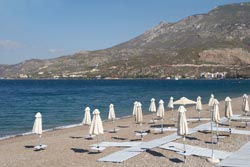 Western Corinthia
Western Corinthia
Scattered along the National Road between Corinth and Patras are pretty little villages looking onto the sea. Villages that promise a quiet corner, a dish of good food savouring of the sea, a friendly word, a swim, hot sand and unforgettable afternoons. You pass a chain of villages - Perigiali, Assos, Vrahati, Kokoni, Velo - before reaching Kiato. a low midst of a huge orchard.
On the shore octopus, the fisherman's favourite food are hanging, drying in the sun. There are no antiquities here, just sand and pebbles being tossed tirelessly by gentle waves. You leave Kiato for a quick visit to the Hellenistic ruins of Sicyon (Sikiona).
Of the ancient city, the ruins of the agora, a temple, the bouleuterion, theatre and stadium still stand. The Roman baths, the most important monument have been repaired and converted into a museum where finds from the site are exhibited. Returning to the coast road, the villages pass before your eyes in an endless procession.
Diminio, Melissi. Sikia, Xilokastro - any one of them a pleasant place to break your journey. And all along the way, fruit trees, pines and even palm trees rustle in the breeze. Kamari, Loutro, Likoporia, Derveni. Bays and coves and lapping waves.
Right in the middle of remembrance and forgetfulness. Now you can sit in a taverna, under a grape arbour or in the shade of some leafy free, and enjoy the last of Corinthia.
A charcoal grilled fish, wild greens, fried cheese, olives, wine under the scented, sun-drenced vines... To your health.

 Coming from Athens, Corinthia is the first prefecture you come to in the Peloponnese, the first sign of warmth and excitement. The aromas of the sea, the mountains, the harvest of grapes and currants are all-encompassing, accompanied by the sound of bees buzzing around the sheds where the currants are drying. Here you'll rediscover some old Greek myths, learn that Nemean wine is called "Herakles blood" and that retsina is the teardrop of a certain wood nymph. You'll find out about gods, nereids and mortals. Zeus and Apolo. You'll come upon columns, sanctuaries and ancient palaces.
Coming from Athens, Corinthia is the first prefecture you come to in the Peloponnese, the first sign of warmth and excitement. The aromas of the sea, the mountains, the harvest of grapes and currants are all-encompassing, accompanied by the sound of bees buzzing around the sheds where the currants are drying. Here you'll rediscover some old Greek myths, learn that Nemean wine is called "Herakles blood" and that retsina is the teardrop of a certain wood nymph. You'll find out about gods, nereids and mortals. Zeus and Apolo. You'll come upon columns, sanctuaries and ancient palaces.
Cutting through Corinthia
Just before the Isthmus, to the right, the road veers off to Loutraki, a town built on the foothills of the Gerania range on the soil of Central Greece, yet still part of Corinthia prefecture.
The cloudless sky is reflected in the sea. You watch the carefree movements of the people on the beach, swimming and tanning themselves in the summer sun. But Loutraki also has hot springs, whose blessed waters gush from the earth with healing properties. Beyond Loulraki, heading west, you come to lake Vouliagmeni which is joined to the sea by a narrow channel
Near Perahora peninsula, with its picturesque bay, you see the first ruins at the back of the harbour - the Temples of Hera Akraia and Limenia.
This place gives one a foretaste of what to expect from the main sanctuary to Hera in the Peloponnese.
 Returning to the main highway for Corinth, you pass the Isthmus, - the avlaki or "courtyard" as we Greeks call it - and head for one of the most important panhellenic shrines, the sanctuary of Poseidon at Isthmia (7th c. BC), near the village of Kiravrisi, where panhellenic games were held every other year.
Returning to the main highway for Corinth, you pass the Isthmus, - the avlaki or "courtyard" as we Greeks call it - and head for one of the most important panhellenic shrines, the sanctuary of Poseidon at Isthmia (7th c. BC), near the village of Kiravrisi, where panhellenic games were held every other year.
Adjacent to the archaeological site is a museum containing important finds. The paintings on glass are most impressive. From here the road leads to Kehries, the eastern port Corinth on the Saronic Gulf.
Ancient foundations, most of which are submerged, were excavated at the harbour's two quays.
Traces of the temple of Isis and an early Christian basilica constructed on top of the temple can be distinguished.
Immediately afterwards you reach Baths of Belle Helene (Loutro Elenis), a resort area with lovely beaches and hot springs, the seaside village of Almiri; and then Korfos a hamlet built at the head of a small bay.
The region is thick with pine and olive trees.
The coast and the little ports in the vicinity are unforgetable. Hard for a visitor to leave behind.
Here one can find good food and a house to stay in, surrounded by beauty.
Corinth yesterday and today
In the age of myth Corinthia was always being thrown into turmoil by tribes pouring into the Peloponnese from the Isthmus. With the setting of the Dorians (9th c. BC), Corinth's history began.
It beacame a great naval power and perfected the trireme. The Corinthians were the first to have the idea cutting through the Isthmus but were unable to accomplish this feat. Instead they invented and built a paved slipway, called the diolkos, to haul their boats overt Isthmus. They were foremost in the arts, particula ceramics. The 5th century was their most glorious period.
But with the success of Athena as a powerful force, Corinth was eclipsed and fell into decline.
In 146 BC the Romans completely destroyed the city. In 67 BC Nero tried his hand at digging through the Isthmus and got as far as a big trench, but works were abandoned with his death, and not until 1891-1893 did the canal finally become a reality .
Invasions and looting by barbarians threw Corinth into a new decline and the city was not heard from again until the early Byzantine era.
In 1521 a strong earthquake razed the city which rose again in about the 11th century.
In 1212 the Franks took over, holding on until 1395 when the Byzantines gained the advantage, only to sell the city to the Knights of Rhodes five years later. Corinth, with the most of the rest of the Peloponnese, fell to the Turks in 1458, became the property of the Knights of Malta for a time (1612), passed to the Venetians in 1687 and was recaptured by the Turks in 1715, They were ousted in 1822.
 Today Corinth (Korinthos) ranks among Greece's most important cities and is a major transportation hub. The church of the Apostle Paul reminds us of the saint's Letters to the Corinthians and his preaching here. Its long waterfront is one of the most attractive spots in the city.
Today Corinth (Korinthos) ranks among Greece's most important cities and is a major transportation hub. The church of the Apostle Paul reminds us of the saint's Letters to the Corinthians and his preaching here. Its long waterfront is one of the most attractive spots in the city.
Its numerous pastry shops, restaurants, tavernas, bars, cinemas and nightclubs make Corinth lively in both winter and summer. In September and October a theatre festrival is held here with troupes from all over the Balkans as weil as a panhellenic amateur theatre contest. Ancient Corinth
The ruins of ancient Corinth are spread out at the foot of the huge rock of Acrocorinth. The monuments are mainly Roman, only a few are Greek.
You can trace the Long Walls which began at the summit of Acrocorinth and descended all the way to Lechaion (Leheo), the artificial harbour on the Corinthian Gulf.
Lechaion was the start of Lechaion road which led 1o the ancient agora. This was paved with flagstones and lined with sidewalks, arcades and shops. The area of the marketplace was filled with imposing buildings, temples and business emporia. The Doric temple of Apollo (6th c. BC with 1st c. AD restorations) stands on a knoll to the north of the agora;
it is the most important monument of that period. To the northwest of the agora lie the ruins of the 4th century BC theatre - which underwent some changes in the Roman era - and the Roman Odeon. The museum is in the southwest sector of the site. It contains mosaic floors, Mycenaean and Corinthian pottery, terra cotta sphinxes, statues of two supernatural beings, relief plaques, the Roman head of the Goddess Tyche and small objects of various kinds. On the north side of the building one can see the remains of the fountain of Glauke hewn out of the rock. Glauke, daughter of King Creon, was the reason why Jason deserted Medea. In revenge Medea sent her as a wedding gift a poisoned mantle which envelopped the girl in flames the moment she put it on. In order to save herself she leapt into the fountain which since then has borne her name.

Acrocorinth
The imposing mass of Acrocorinth (Acrokorinthos)-rises out of the ground at the edge of the ancient city. At the top of the pinnacle, at an altitude of 575 metres, stood the acropolis of Corinth during ancient and medieval times. This is the largest and oldest fortress in the Peloponnese. The Franco-Byzantine-Venetian fortifications (built atop the ancient walls) ana Turkish additions have left deep signs of their successive claims to supremacy.
At the summit, which offers a magnificent view, there were a vast number of shrines and temples dominated by the Temple of Aphrodite. Lower down is Ihe Upper Peirene Spring.
Pausanias mentions that Peirene was a woman who was transformed into a spring by the tears she shed for her son who had been killed by Artemis.
The mountains of Corinthia
From Acrocorinth the road continues on to Nemea. Here the soil is yellow, dry, ideal for the cultivation of grapes. The whole district is covered with vines. The neighbouring village of Herakleio is a silent withness to the passing of the mighty Herakles. It was in this area that the legendary hero slew the fearsome Lion of Nemea.
There is not much left of ancient Nemea: three columns from the temple of Zeus, a few foundations, the outline of a palaestra and, 500 metres down road, the stadium. It was here that the panhellenic Nemean Games were held, in honour of some local hero. They took place every two years and the vicitors' reward was a crown of wild celery.
From Nemea the road leads to Stimfalia, a mountain village in the region of Ziria.
The lake no longer harbours man-eating, iron-winged birds; they were destroyed by Herakles.
All that is left is the ruined temple of Artemis and the walls that encircled the old city.
In the region there is also a Prankish church (13th c.) and ruins of a Frankish castle
At the foothills of Ziria (Mt. Killini, where Pausanias had seen white blackbirds), between the villages of Goura and Feneos. every year on the second Sunday of September a big fair is held. The road proceeds to Kastania, a charming mounlain village (alt. 920 m ), surrounded by fir trees It is one of the most popular places in Corinthia for a winter holiday
One more revelation amongst the pine - and fir-clad slopes of Ziria is the village of Trikala (alt. 1,300m.). The Ziria mountaineers' hostel lies 5 km from here. Back in Nemea you come next to tile pass of Dervenakia where the "Old Man of the Morea", Kolokotronis. routed a Turkish army.
The road for Argos runs through it, while another road leads to Hiliomodi, Klenia and Agionori, where there is a medieval castle and a church with lovely frescoes.
 Western Corinthia
Western Corinthia
Scattered along the National Road between Corinth and Patras are pretty little villages looking onto the sea. Villages that promise a quiet corner, a dish of good food savouring of the sea, a friendly word, a swim, hot sand and unforgettable afternoons. You pass a chain of villages - Perigiali, Assos, Vrahati, Kokoni, Velo - before reaching Kiato. a low midst of a huge orchard.
On the shore octopus, the fisherman's favourite food are hanging, drying in the sun. There are no antiquities here, just sand and pebbles being tossed tirelessly by gentle waves. You leave Kiato for a quick visit to the Hellenistic ruins of Sicyon (Sikiona).
Of the ancient city, the ruins of the agora, a temple, the bouleuterion, theatre and stadium still stand. The Roman baths, the most important monument have been repaired and converted into a museum where finds from the site are exhibited. Returning to the coast road, the villages pass before your eyes in an endless procession.
Diminio, Melissi. Sikia, Xilokastro - any one of them a pleasant place to break your journey. And all along the way, fruit trees, pines and even palm trees rustle in the breeze. Kamari, Loutro, Likoporia, Derveni. Bays and coves and lapping waves.
Right in the middle of remembrance and forgetfulness. Now you can sit in a taverna, under a grape arbour or in the shade of some leafy free, and enjoy the last of Corinthia.
A charcoal grilled fish, wild greens, fried cheese, olives, wine under the scented, sun-drenced vines... To your health.

